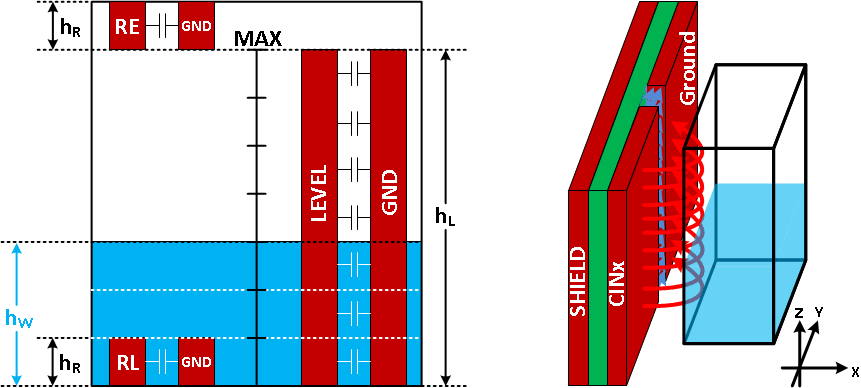SLYA076 july 2023 TMAG5273
2.1 Capacitive
Conventional FDC1004: Basics of Capacitive Sensing and Applications typically measure the change in capacitance between sensors attached to the exterior walls of a tank made of non-conductive material, like plastic. In Figure 2-1, the level-detecting sensors are represented by LEVEL and GND, while additional pairs of capacitive sensors provide a reference for the liquid (RL, GND below) and for the outside environment (RE, GND). These sensors enable environmental tracking, such as temperature-related shifts, in the liquid and the surrounding environment.
This conventional level-sensing method imposes a non-zero potential on the liquid being measured, which makes it susceptible to grounded interference or parasitic capacitance on the system, such as a hand close to or touching the tank. Note that, in general, capacitive sensing can have difficulty sensing the level of thicker solutions like clothes washing detergent, or conductive solutions such as salt water. A downside to the capacitive approach is liquid sticking to the walls of the container. This can severely impact the accuracy of the system if the liquid is a solvent or cleaning solution with a higher viscosity.
 Figure 2-1 Capacitive Liquid Level
Sensing
Figure 2-1 Capacitive Liquid Level
SensingAnother implementation for capacitive liquid level sensing is the Capacitive Sensing: Out-of-Phase Liquid Level Technique which uses a symmetrical sensor layout as well as equal-and-opposite waveforms for the level sensors (LEVEL, GND above). The result is that the liquid under measurement is at or near zero potential, which reduces the system’s sensitivity to interference or parasitic capacitance, such as a hand or other grounded object near the tank. The OoP technique could be implemented in Figure 2-1by replacing the GND sensor in the LEVEL/GND sensor pair with a sensor driven by a signal equal-and-opposite to the LEVEL sensor’s waveform.
An OoP sensor array implemented as a flex PCB is available as the Capacitive-Based Liquid Level Sensing Sensor Reference Design. It is compatible with the FDC1004 4-Channel Capacitance-to-Digital Converter for Capacitive Sensing Solutions, a 4-channel, 16-bit, capacitance-to-digital converter with active shield driver. For more information on capacitive liquid-level sensing please see the E2E FDC1004 Frequently Asked Questions page.